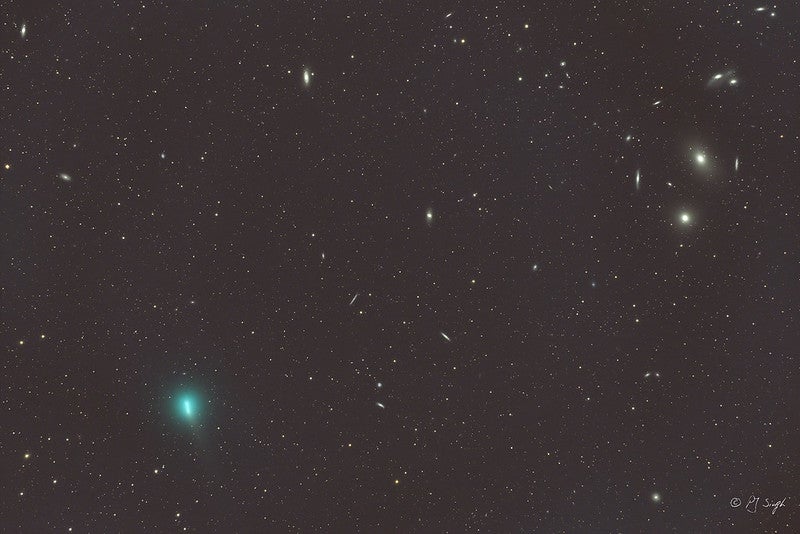
Friday, February 9
With New Moon occurring at 5:59 P.M. EST today, it’s the perfect opportunity to try to catch the zodiacal light this evening.
This soft glow is generated by sunlight scattering off dust in the plane of the solar system, called the ecliptic. The debris is left by Sun-orbiting comets, which shed both dust and gas when they enter the inner regions of the solar system and warm up, generating a tail. Eventually this dust settles onto the ecliptic and causes the zodiacal light.
The best way to spot it is to wait until the sky grows dark after sunset and look west. You’ll need to be in a dark spot far from any town or city lights, as any light pollution will easily wash out the faint phenomenon. The zodiacal light typically looks like a cone-shaped glow jutting up from the horizon. Because the planets are also on the ecliptic, follow them as a rough guide of where the glow will be. At this time of year, the zodiacal light rises up through Aquarius (which holds the setting planet Saturn, close to the horizon), Pisces, and Aries (where bright Jupiter is located). From a good dark location, you may even see the tip of the cone extending up into Taurus, ending near the Pleiades.
Sunrise: 7:01 A.M.
Sunset: 5:29 P.M.
Moonrise: 7:12 A.M.
Moonset: 5:14 P.M.
Moon Phase: New
*Times for sunrise, sunset, moonrise, and moonset are given in local time from 40° N 90° W. The Moon’s illumination is given at 12 P.M. local time from the same location.
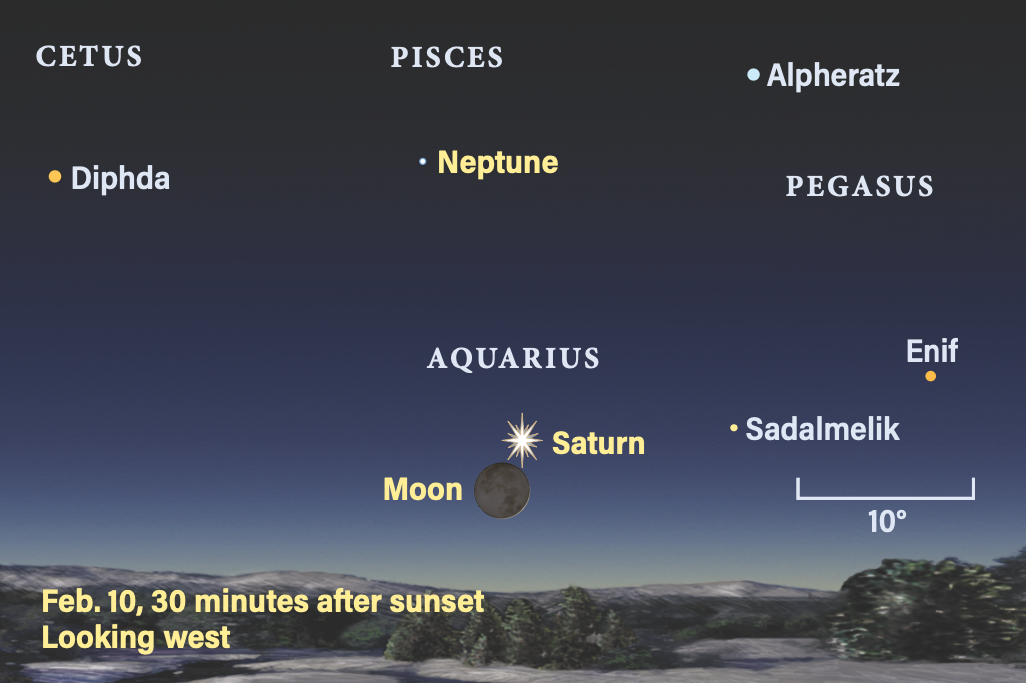
Saturday, February 10
The Moon reaches perigee, the closest point to Earth in its orbit, at 1:53 P.M. EST. At that time, it will be 222,506 miles (358,089 kilometers) away.
Our delicate, barely there crescent Moon passes 1.8° south of Saturn at 8 P.M. EST this evening. Step outside about 30 minutes after sunset to try to spot the pairing close to the western horizon, just 6° high at that time. They lie in the constellation Aquarius, now setting shortly after the Sun.
The Moon, just over one day old, still sits about 2° north of the magnitude 0.9 planet. You should be able to catch them together in binoculars, or perhaps together in a wide-field telescope. Be quick — they’ll set within about an hour of the Sun. An observing site with some altitude above the surrounding terrain will make it easier.
Some 19.5° above the pair is Neptune, the solar system’s most distant planet. Located in Pisces and glowing faintly at magnitude 7.8, you’ll need at least binoculars to spot this world. You can use magnitude 4.5 Lambda (λ) Piscium as a closer signpost — this star sits just 4.7° north of Neptune and should be visible in the same binocular field of view.
Even higher in the sky is magnitude –2.3 Jupiter in Aries. It’s the brightest point of light in this region of sky, and we’ll be sure to return to it later this week to check out the action among its Galilean moons.
Sunrise: 6:59 A.M.
Sunset: 5:30 P.M.
Moonrise: 7:46 A.M.
Moonset: 6:35 P.M.
Moon Phase: Waxing crescent (1%)
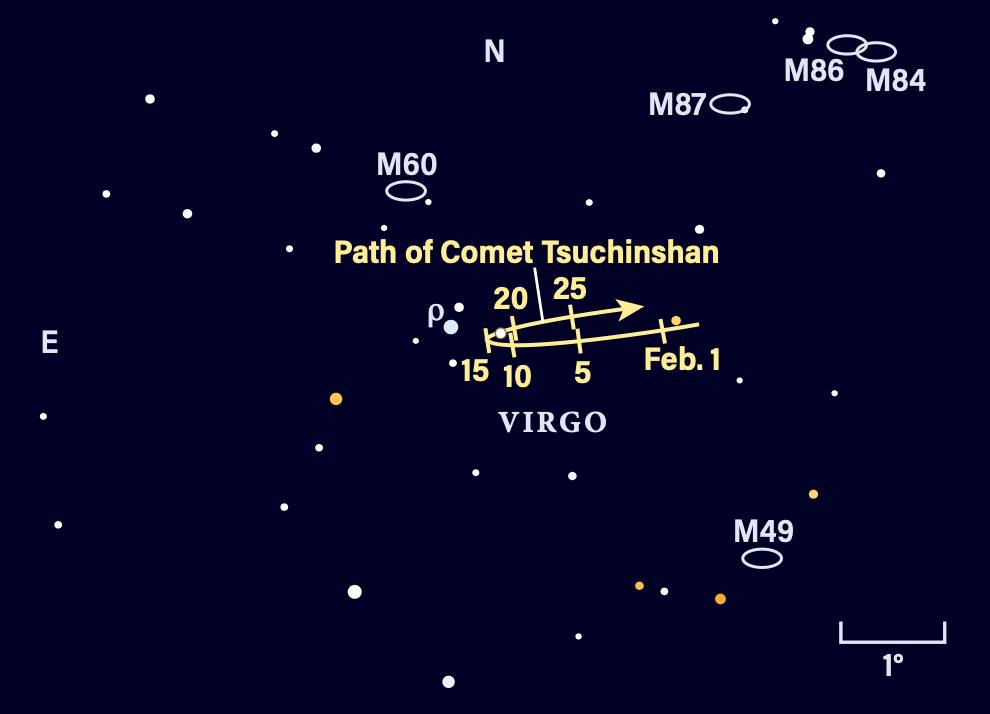
Sunday, February 11
Although Comet 12P/Pons-Brooks is getting plenty of press, it’s not the only comet worth watching. Comet 62P/Tsuchinshan is only about a magnitude fainter (last recorded around magnitude 9) and lies in the constellation Virgo, spending all its time this month near the famous Virgo Galaxy Cluster, offering both imagers and visual observers an eyeful of treats.
This comet is a target for early risers. Two hours before sunrise, Virgo is about 45° high in the south. Those familiar with its namesake cluster will know we’re zooming in on the constellation’s northwestern region, between the two stars Epsilon (ϵ) and Omicron (ο) Virginis. Tsuchinshan itself is located 5.5° west-southwest of Epsilon, and just 0.5° southwest of 5th-magnitude Rho (ρ) Vir. This morning, the comet lies just a few arcminutes south of a 6th-magnitude field star.
Within just a few degrees of the comet are several relatively bright galaxies. M49 sits just over 3° southwest of Tsuchinshan, while M59 lies less than 2° to the comet’s north-northeast. M58 is a similar distance to the north-northwest of Tsuchinshan, and the famous elliptical galaxy M87 is just over 3° northwest of the comet. Many more galaxies abound, particularly for those with larger scopes or taking photos. Make sure to enjoy the view and keep coming back night after night for more; Tsuchinshan will stand stationary in just a few days and begin inching its way westward after that, remaining close to the same spot all month.
Sunrise: 6:58 A.M.
Sunset: 5:31 P.M.
Moonrise: 8:14 A.M.
Moonset: 7:54 P.M.
Moon Phase: Waxing crescent (5%)
Monday, February 12
The Moon now passes 0.7° north of Neptune at 3 A.M. EST. By evening, they are nearly 10° apart, with Luna hanging above the spot where Neptune sits. The distant ice giant is just 21′ west of a magnitude 5.5 field star, HIP 11735.
The Moon is now some 14 percent lit and just over 3 days old. Its eastern limb is illuminated, particularly the large, round, flat-bottomed Mare Crisium. The dark color of this feature signifies that it is relatively young, as age tends to lighten terrain on the Moon. It was formed by cooled lava that welled up in response to a massive asteroid impact.
To Crisium’s south is the large crater Langrenus. About 85 miles (137 km) wide, it sports a cluster of central peaks that rise a mile or more above the flatter floor of the crater. Langrenus is a circular crater that often appears oblong because of foreshortening as we see it on the rounded surface of the Moon. It’s also a great target for your telescope — especially so young in the lunar day, when shadows create excellent contrast and bring out details in the area.
Sunrise: 6:57 A.M.
Sunset: 5:32 P.M.
Moonrise: 8:40 A.M.
Moonset: 9:10 P.M.
Moon Phase: Waxing crescent (11%)
Tuesday, February 13
Jupiter’s volcanic moon Io is trekking across the giant planet’s disk this evening, best seen by observers in the eastern half of the U.S. Io crosses onto the disk from the east around 7:10 P.M. EST, with Europa far east of the planet, and Callisto (closer) and Ganymede west of Jupiter.
The moon takes just over two hours to cross, slipping off the western limb around 9:20 P.M. EST. Although West Coast observers will only catch some of this journey, it will be easier for those in the western U.S. to follow Io’s shadow, which appears against the cloud tops around 8:30 P.M. EST. The shadow takes a similar amount of time to cross, disappearing again just before 10:40 P.M. EST.
Keep watching, and you’ll realize that Callisto is moving east even as Io pulls away from the planet to the west. Around 10:40 P.M. CST (after Jupiter has set in the Eastern time zone), Io moves due south of Callisto as the two moons pass each other, moving in opposite directions.
Sunrise: 6:56 A.M.
Sunset: 5:33 P.M.
Moonrise: 9:06 A.M.
Moonset: 10:24 P.M.
Moon Phase: Waxing crescent (20%)
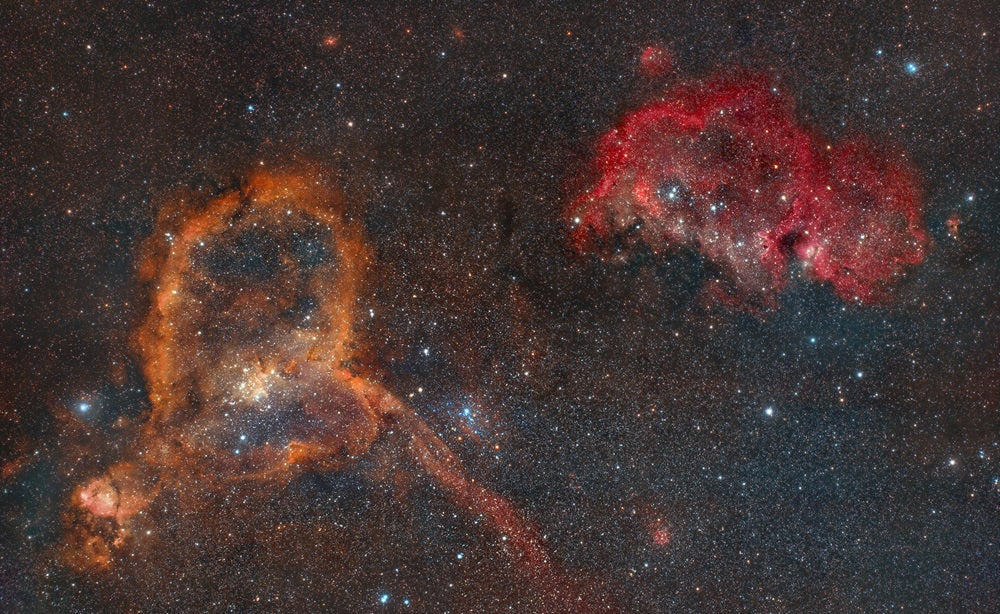
Wednesday, February 14
Let’s celebrate Valentine’s Day with the Heart and Soul nebulae, high in the sky after dark as they circle the North Celestial Pole within the constellation Cassiopeia.
Officially cataloged as IC 1805 and IC 1848, respectively, the Heart and Soul nebulae cover about 5° of sky in the eastern portion of the Queen. They lie roughly 6.3° east-southeast of 3rd-magnitude Segin (Epsilon Cassiopeiae).
Of the two, the Heart Nebula lies farther west and the Soul farther east. Both shine hydrogen red, meaning their nebulosity is rather difficult to pick up by eye — this is perhaps why they are such popular astrophotography targets, as the use of a filter and multiple-exposure stacking brings them out more clearly. These are particularly easy targets for amateur photographers to capture, so if you’re new to astrophotography, give them a try.
Visual observers can easily search out Melotte 15, a star cluster at the center of the Heart Nebula bright enough to pick up with binoculars. These suns are incredibly young at less than 2 million years old. The cluster is sometimes called the Heart of the Heart, thanks to its relatively central location within the larger Heart Nebula.
Sunrise: 6:55 A.M.
Sunset: 5:35 P.M.
Moonrise: 9:32 A.M.
Moonset: 11:39 P.M.
Moon Phase: Waxing crescent (30%)
Thursday, February 15
Trekking along the ecliptic, the Moon passes 3° north of Jupiter at 3 A.M. EST. Luna then passes 3° north of Uranus at 9 P.M. EST. Both planets lie in Aries the Ram, visible in the evening sky.
Let’s focus on this latter pairing tonight as the two sit in eastern Aries, hanging directly above bright Jupiter and directly below the sparking Pleiades star cluster (M45) in Taurus. The Moon lies to Uranus’ upper right in the sky, though you’ll want binoculars or a telescope to spot the distant planet. Glowing at magnitude 5.8, Uranus will look like a grayish, “flat” star with a disk just 4″ wide.
The Moon is now just over 6 days old and is roughly 45 percent lit this evening. It will reach First Quarter, when its Earth-facing nearside is exactly 50 percent lit, tomorrow morning.
As long as you’ve got your binoculars or telescope out to spot Uranus, swing your optics upward to enjoy the Pleiades as well. Known since antiquity, this naked-eye cluster looks to many like a tiny version of the Big or Little dippers. (In fact, some mistake it for the Little Dipper, though that asterism is much larger!) You’ll want low-powered optics to best enjoy this lovely scatting of young stars, as there are so many and they are so spread out — the cluster takes up about 110′ of sky — you won’t want to zoom in too much.
Sunrise: 6:53 A.M.
Sunset: 5:36 P.M.
Moonrise: 10:00 A.M.
Moonset: —
Moon Phase: Waxing crescent (41%)
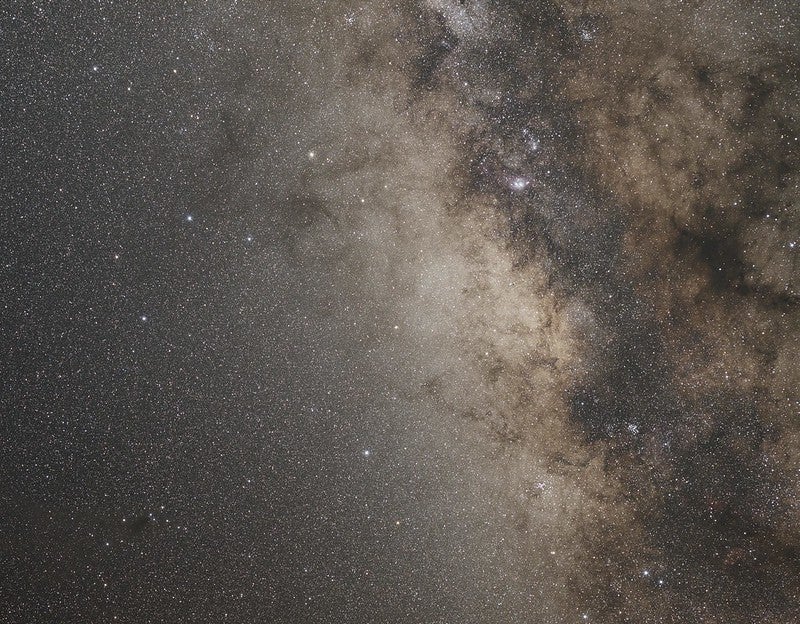
Friday, February 16
Roughly an hour before the Sun rises, look southeast to see if you can spot the Teapot asterism of Sagittarius, low on the horizon to the upper right of bright Venus and fainter Mars, both rising in the east. It lies to the lower left of the Milky Way; the plane of the galaxy sits low to the southeastern horizon at this time, so you’ll need a very dark observing site to see it before the sky starts to quickly lighten with the approaching dawn.
Venus is unmissable, blazing at magnitude –3.9, although it’s just 3° above the horizon. You may need to wait a bit longer to catch sight of Mars to its lower left, magnitude 1.3 and less than 1° high at this time. The Red Planet is rising and will reach about 5° in altitude some 30 minutes before sunrise, as the stars are disappearing from the sky.
Although it’s not possible to observe in the growing daylight, the dwarf planet Pluto is finally climbing out of solar opposition, which it reached last month. It now sits just below Venus and to the right of Mars. The tiny world won’t reach opposition until late July, when it will rise at sunset and remain visible all night long.
First Quarter Moon occurs at 10:01 A.M. EST.
Sunrise: 6:52 A.M.
Sunset: 5:37 P.M.
Moonrise: 10:33 A.M.
Moonset: 12:52 A.M.
Moon Phase: Waxing gibbous (51%)

Sky This Week is brought to you in part by Celestron.









